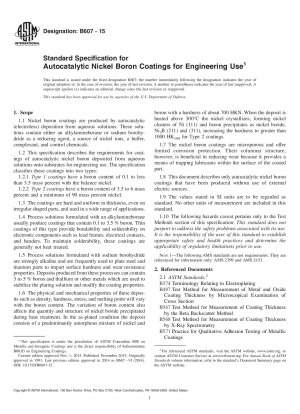ASTM B607-15
Standard Specification for Autocatalytic Nickel Boron Coatings for Engineering Use
- Standard No.
- ASTM B607-15
- Release Date
- 2015
- Published By
- American Society for Testing and Materials (ASTM)
- Status
- Replace By
- ASTM B607-21
- Latest
- ASTM B607-21
- Scope
1.1 Nickel boron coatings are produced by autocatalytic (electroless) deposition from aqueous solutions. These solutions contain either an alkylamineborane or sodium borohydride as a reducing agent, a source of nickel ions, a buffer, complexant, and control chemicals.
1.2 This specification describes the requirements for coatings of autocatalytic nickel boron deposited from aqueous solutions onto substrates for engineering use. The specification classifies these coatings into two types:
1.2.1 Type 1 coatings have a boron content of 0.1 to less than 3.5 mass percent with the balance nickel.
1.2.2 Type 2 coatings have a boron content of 3.5 to 6 mass percent and a minimum of 90 mass percent nickel.
1.3 The coatings are hard and uniform in thickness, even on irregular shaped parts, and used in a wide range of applications.
1.4 Process solutions formulated with an alkylamineborane usually produce coatings that contain 0.1 to 3.58201;% boron. Thin coatings of this type provide bondability and solderability on electronic components such as lead frames, electrical contacts, and headers. To maintain solderability, these coatings are generally not heat treated.
1.5 Process solutions formulated with sodium borohydride are strongly alkaline and are frequently used to plate steel and titanium parts to impart surface hardness and wear resistance properties. Deposits produced from these processes can contain 3 to 58201;% boron and thallium or other metals which are used to stabilize the plating solution and modify the coating properties.
1.6 The physical and mechanical properties of these deposits such as density, hardness, stress, and melting point will vary with the boron content. The variation of boron content also affects the quantity and structure of nickel boride precipitated during heat treatment. In the as-plated condition the deposit consists of a predominantly amorphous mixture of nickel and boron with a hardness of about 700 HKN. When the deposit is heated above 300°C the nickel crystallizes, forming nickel clusters of Ni (111) and boron precipitates as nickel boride, Ni3B (211) and (311), increasing the hardness to greater than 1000 HK100 for Type 2 coatings.
1.7 The nickel boron coatings are microporous and offer limited corrosion protection. Their columnar structure, however, is beneficial in reducing wear because it provides a means of trapping lubricants within the surface of the coated part.
1.8 This document describes only autocatalytic nickel boron coatings that have been produced without use of external electric sources.
1.9 The values stated in SI units are to be regarded as standard. No other uni......
ASTM B607-15 Referenced Document
- ASTM B374 Standard Terminology Relating to Electroplating
- ASTM B487 Standard Test Method for Measurement of Metal and Oxide Coating Thickness by Microscopical Examination of Cross Section
- ASTM B567 Standard Test Method for Measurement of Coating Thickness by the Beta Backscatter Method*, 2024-04-20 Update
- ASTM B568 Standard Test Method for Measurement of Coating Thickness by X-Ray Spectrometry
- ASTM B571 Standard Practice for Qualitative Adhesion Testing of Metallic Coatings
- ASTM B578 Standard Test Method for Microhardness of Electroplated Coatings
- ASTM B602 Standard Test Method for Attribute Sampling of Metallic and Inorganic Coatings
- ASTM B656
- ASTM B667 Standard Practice for Construction and Use of a Probe for Measuring Electrical Contact Resistance
- ASTM B678 Standard Test Method for Solderability of Metallic-Coated Products
- ASTM B697 Standard Guide for Selection of Sampling Plans for Inspection of Electrodeposited Metallic and Inorganic Coatings
- ASTM B762 Standard Test Method of Variables Sampling of Metallic and Inorganic Coatings
- ASTM D2670 Standard Test Method for Measuring Wear Properties of Fluid Lubricants (Falex Pin and Vee Block Method)
- ASTM D2714 Standard Test Method for Calibration and Operation of the Falex Block-on-Ring Friction and Wear Testing Machine
- ASTM D4060 Standard Test Method for Abrasion Resistance of Organic Coatings by the Taber Abraser
- ASTM E39 Methods for Chemical Analysis of Nickel
- ASTM F519 Standard Test Method for Mechanical Hydrogen Embrittlement Evaluation of Plating Processes and Service Environments
- SAE AMS2399 ELECTROLESS NICKEL-BORON PLATING
- SAE AMS2433 ELECTROLESS NICKEL-THALLIUM-BORON PLATING
ASTM B607-15 history
- 2021 ASTM B607-21 Standard Specification for Autocatalytic Nickel Boron Coatings for Engineering Use
- 2015 ASTM B607-15 Standard Specification for Autocatalytic Nickel Boron Coatings for Engineering Use
- 2014 ASTM B607-91(2014) Standard Specification for Autocatalytic Nickel Boron Coatings for Engineering Use
- 1991 ASTM B607-91(2009) Standard Specification for Autocatalytic Nickel Boron Coatings for Engineering Use
- 1991 ASTM B607-91(2008) Standard Specification for Autocatalytic Nickel Boron Coatings for Engineering Use
- 1991 ASTM B607-91(2003) Standard Specification for Autocatalytic Nickel Boron Coatings for Engineering Use
- 1991 ASTM B607-91(1998) Standard Specification for Autocatalytic Nickel Boron Coatings for Engineering Use

Copyright ©2024 All Rights Reserved